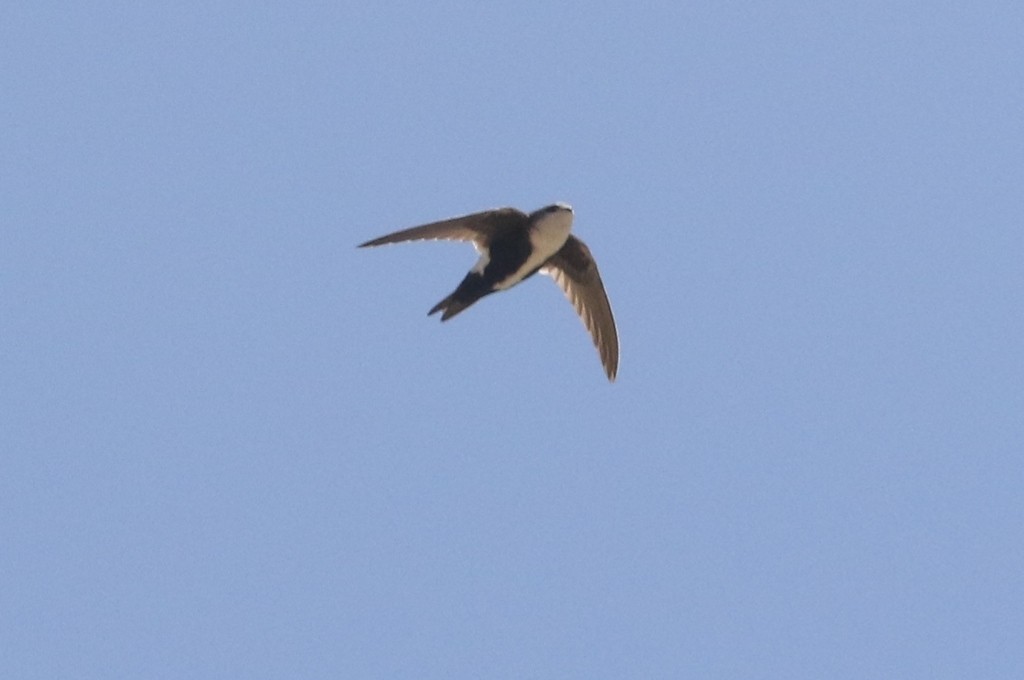White-throated Swift
A species of American Black-and-white Swifts Scientific name : Aeronautes saxatalis Genus : American Black-and-white Swifts
White-throated Swift, A species of American Black-and-white Swifts
Botanical name: Aeronautes saxatalis
Genus: American Black-and-white Swifts
Content
Description People often ask General Info
 Photo By silversea_starsong , used under CC-BY-NC-4.0 /Cropped and compressed from original
Photo By silversea_starsong , used under CC-BY-NC-4.0 /Cropped and compressed from original Description
The White-throated swift is medium-sized bird that is primarily black and white. Its back and wings are blackish-brown or black, and its breast, belly, chin, and throat are white. In newly molted adults, the dark feathers may have a slight greenish sheen, though this is rarely observable in the field. Sexes cannot be distinguished by plumage. Juvenile (first basic) plumage is similar to adult (definitive basic) plumage, but with the feathers on juveniles' heads and necks appearing duller and paler. Adults are generally 15–18 centimeters in length, and have a tail with a relatively shallow 10 millimeter-deep notch. Adult swifts weigh between 28 and 36 grams, with a mean weight recorded as 32.5 grams, and there is no difference in size between males and females. The white-throated swift has a wingspan of 35.5 cm. White-throated swifts can appear similar to Black Swifts and Vaux's Swifts, which also occur in western North America, but White-throated swifts can be distinguished by their white underparts which both other species lack. 
Size
15-18 cm (6-7 in)
Colors
Brown
Black
White
Life Expectancy
10 years
Nest Placement
Cliff
Feeding Habits
White-throated Swift predominantly feed on flying insects and spiders, captured mid-flight through acrobatic maneuvers. They forage alone or in large flocks, often near rising air currents or storm edges, where insects aggregate. Their diet includes various flies, beetles, bees, wasps, and true bugs. They occasionally drink by skimming water bodies, and feed nestlings with a mouthful of arthropods.
Habitat
White-throated Swift thrives in mountainous terrains, preferring environments like cliffs, canyons, and bluffs for nesting and roosting. Elevation ranges are broad, extending from below sea level to above 11,000 feet. While adaptable to diverse terrestrial habitats, crucial factors for residence include the presence of nesting sites and insect prey. White-throated Swift forages over open areas and may migrate across various landscapes, including coastal and high-altitude regions.
Nest Behavior
Both white-throated Swift sexes select nesting sites together. Nest building occurs by gluing collected materials mid-flight using saliva. The interior cup averages 3 inches wide and 1 inch deep. Egg-laying patterns and parental roles in care have not been provided in the references.
Nest Characteristics
White-throated Swift nests are typically found in crevices of rocky terrains, like canyon walls or cliffs, and can be over 20 feet high. Occasionally, they may use old nests from other birds. Their nests are shallow cups fashioned from feathers, grass, mosses, plant down, bark, and glued together with saliva. Sizes can vary, but they generally measure about 5 inches wide and 2 inches tall.
Dite type
Insectivorous
People often ask
General Info
Feeding Habits
Bird food type
Sounds
Call
Recording location: Mexico
Behavior
White-throated Swift engage in dynamic social behaviors, including communal roosting and shared nesting territories. Their daily activities revolve around aerial acrobatics which are part of their courtship and possibly mating rituals. White-throated Swift form flocks, showcasing their social nature, to collectively forage and care for their young. Particularly during nesting, these birds demonstrate remarkable agility, plummeting in paired dives—a behavior whose full purpose remains a mystery. They are not known to be territorial, often nesting in close proximity, essentially forming colonies. The coordination within these groups is evident as they communicate vocally while foraging and returning to the nests.
Distribution Area
White-throated swifts are year-round residents of coastal and southern California, southern Arizona, southern New Mexico, western Texas, central Mexico, and the Sierra Madre Occidental and Oriental mountains. Migratory breeding populations can be found from Arizona and New Mexico north to southern British Columbia, and from central California east to eastern Colorado and Wyoming. In the southern part of its migratory range, birds arrive in mid-March and depart in mid-October, while in the northern portion, they do not arrive until mid-April to early-May, and depart in late-August to mid-September. There are two main areas in which non-breeding wintering populations can be found: the first includes southwestern California, eastern Arizona, the Texas Panhandle, while the second is in El Salvador, Guatemala, Honduras, and the Mexican state of Chiapas. 
Species Status
Across North America, White-throated swift populations have declined by 2.8% from 1966–1998, which is considered to be a significant decline. Such declines could be related to loss of roosting and nesting sites from quarrying, mining, and the demolition of older buildings, as well as reduction in food supply due to pesticide use. However, in certain areas swift populations appear to have increasing trends, and most populations appear stable. The patchy distribution of this species makes interpreting these data difficult, but the apparent overall decline is of concern given the concurrent declines of other aerial insectivores. 
Scientific Classification
Phylum
Chordates Class
Birds Order
Swifts and hummingbirds Family
Swifts Species
White-throated Swift